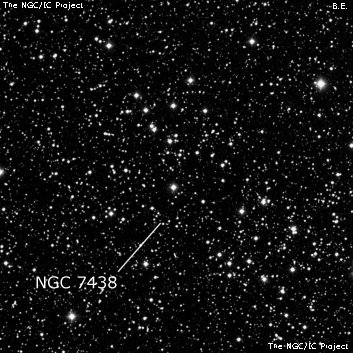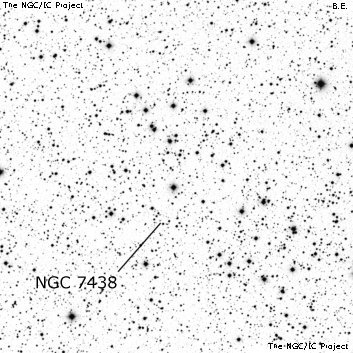NGC/IC Project Restoration Effort
(This is a very very beta version)
NGC7438


Basic Information
Location and Magnitude
Right Ascension: 22:57:20.0
Declination: +54:18:38
Constellation: CAS
Visual Magnitude:
Historic Information
Discoverer: Herschel J.
Year of discovery: 1831
Discovery aperture: 18.3
Observational
Summary description: Cl, vL, E
Sub-type: *Grp
Corwin's Notes
=====
NGC 7438. JH describes this as "A large oblong cluster which fills two
fields. Place that of the double star h. 3157 of my fifth Catal." DSS and
POSS show a cloud of stars, elongated southwest to northeast, more compressed
on the southwestern end into two apparent clusters separated by about 10
arcmin. Though well-defined on that end, it is very poorly defined on the
northeastern side. The overall dimensions are roughly 30 arcmin by 10 arcmin.
I doubt that the entire group is a cluster, though the southeastern-most two
clumps might well be. Those portions of JH's object could stand out well in
even small telescopes since the stars are fairly bright, 9th to 11th
magnitudes.
-----
In one-degree DSS and DSS2 images centered on JH's position, the cloud of
stars seems to break up into three discrete clumps, not just two. There are
absorption patches and streaks all across the field, and these serve to define
the separate "clusters" as much as the distribution of stars. I'm even less
convinced now that all this represents a real cluster. Nevertheless, I'm
giving the positions and sizes of the three clumps as hopefully representing
what JH saw on that night in November 1831. Note that the clump I previously
named "NGC 7438 ne" is now named "NGC 7438 m", and "NGC 7438 ne" is a "new"
clump on to the northeast.
Steve's Notes
=====
NGC 7438
17.5" (8/13/96): at 100x, there is a 20' elongated group of stars separated into two distinct scattered subgroups. The SW group is circular, ~6' diameter with roughly three dozen stars total, although there are a dozen brighter mag 10/11 stars which form the circular outline. Only a few faint stars populate the interior of the outline. The NE group is more elongated, ~7'x5', with two dozen stars. It includes a nice well-matched mag 11 pair at 15" separation. The two groups only stand out in a rich Milky Way field using a 20 Nagler but it still looks like a random grouping. Listed as nonexistent in Carlson and RNGC.



